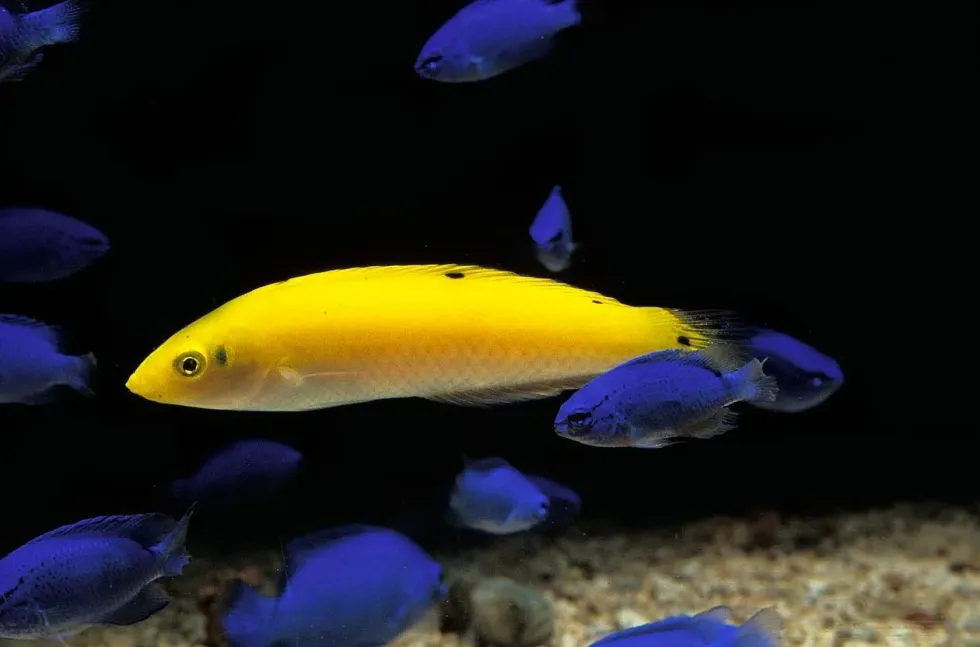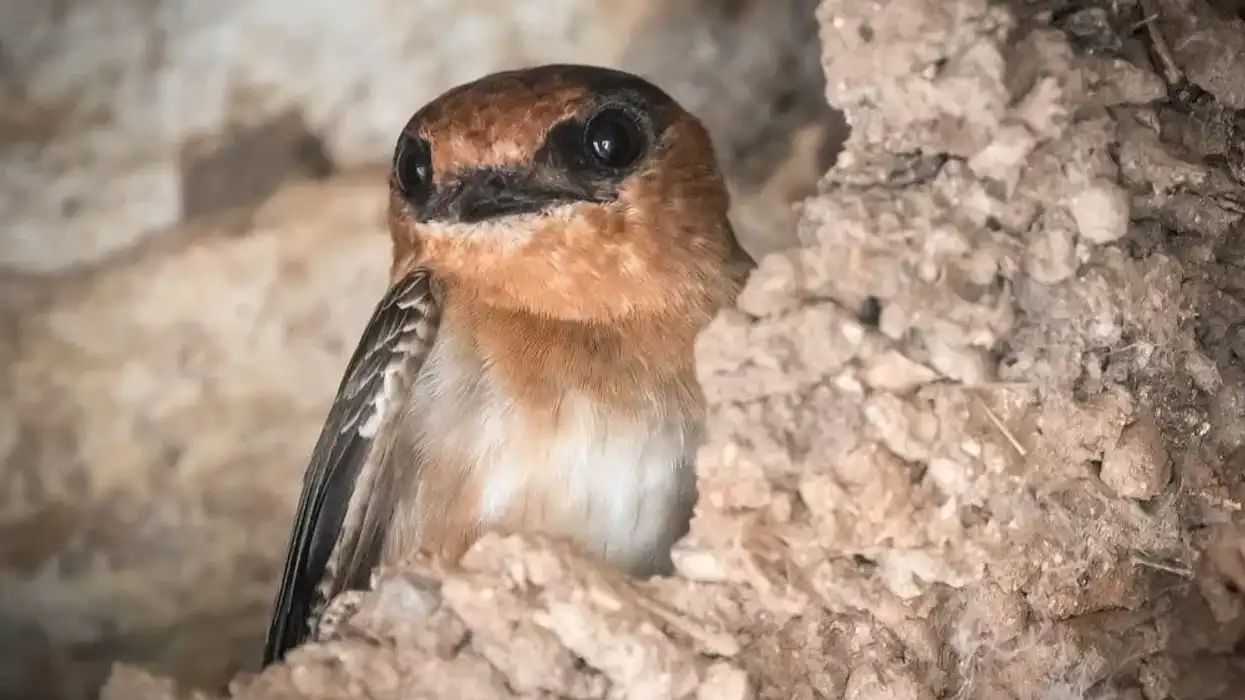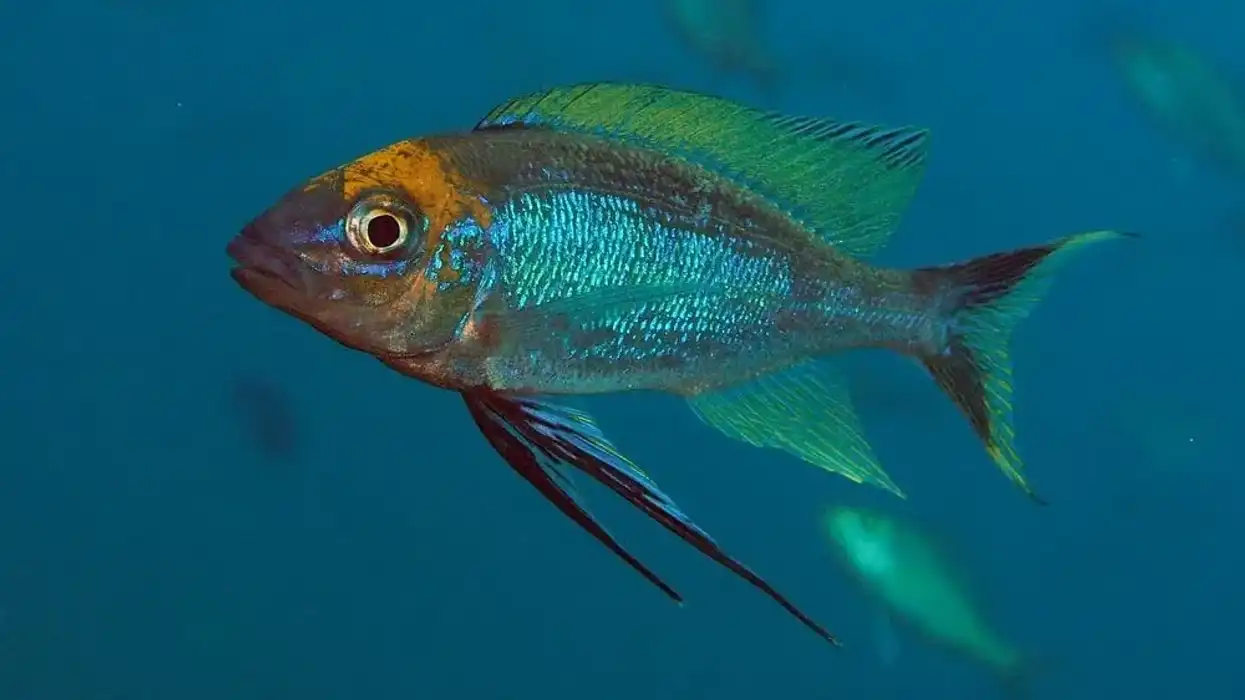The canary wrasse, also known as the yellow wrasse or golden rainbowfish, is a variety of small fish found in parts of the Indian and Pacific oceans. This fish is also a very common sight in household aquaria.
Canary wrasses have a vibrant appearance due to the bright yellow coloration of their body. Additionally, they also have small spots on their dorsal fins.
While adult male and female fish have one spot and two spots, respectively, young juvenile canary wrasses have three. In the wild, these fish live in reef edges, up to a depth of 229.6 ft (70 m).
However, in captivity, they do well in large tanks with salt water, and a sand bottom, instead of a bare bottom. They are carnivorous in nature, and their diet includes snails, worms, and crustaceans like shrimps. Being a reef-safe species, these wrasses do not eat soft or stony corals.
They are very active in nature and are considered to be semi-aggressive. However, they mostly remain peaceful in fish tanks.
To learn more about the canary wrasse, keep reading! You can also check out facts about the wrasse and the humphead wrasse.
Canary Wrasse Interesting Facts
What type of animal is a canary wrasse?
The canary wrasse is a kind of bright and small marine fish. This fish has many other names including the golden wrasse, yellow coris, yellow coris wrasse, yellow wrasse, golden rainbowfish, and so on.
What class of animal does a Canary Wrasse belong to?
The yellow coris wrasse (Halichoeres chrysus) is a part of the class Actinopterygii. It is a part of the Labridae family and Halichoeres genus.
How many canary wrasses are there in the world?
The exact number of yellow coris in the world is not known. However, since these wrasses are commonly sold as aquarium fish, it can be assumed that their population is not under any threat.
Where does a canary wrasse live?
The canary wrasse (Halichoeres chrysus) is endemic to the eastern Indian Ocean and western Pacific regions. Some places included in its range are Christmas Island, the Solomon Islands and New South Wales in Australia.
What is a canary wrasse's habitat?
The habitat of a canary wrasse is marine, where it can be found up to a depth of 229.6 ft (70 m). It is seen in reef edges, rubbles, and sandy areas.
In an aquarium, these fish need a tank size of 50 gallons (189.2 l) with saltwater. The bottom of the tank should have adequate sand, instead of being bare bottom, as they like to hide or sleep in the sand substrate. They do better in fish tanks that mimic their reef environment.
Who does canary wrasse live with?
Yellow wrasses live in small groups with members of their own species and have been seen swimming in shoals. However, in an aquarium, they can co-exist with other peaceful fish too.
How long does a canary wrasse live?
These fish are known to live for more than five years in captivity. However, in the wild, their lifespan is estimated to be around 10 years.
How do they reproduce?
Canary wrasses form groups or harems of females, after which one female wrasse changes into a male, as this is a sequential hermaphroditic species. Once this sex change has taken place, spawning occurs. No parental care towards juvenile fish has been observed in this species.
What is their conservation status?
The conservation status of the canary wrasse or yellow coris (Halichoeres chrysus) is marked as Least Concern by the International Union For Conservation Of Nature or IUCN. Though these fish face no serious threat, they are a part of the aquarium trade, which may negatively affect their numbers in the future.
Canary Wrasse Fun Facts
What does a canary wrasse look like?
The canary wrasse or yellow coris wrasse is a small fish with a bright body. This fish has a thin body that looks elongated, with a mouth at the terminal position, meaning it is located in the middle of the head and points forward.
It has a vibrant yellow appearance, with an orangish-yellow head and thorax. The head of this fish also has light-green bands placed irregularly, with whitish spots behind the eyes.
Some minute differences are noticeable between male and female fish of this species.
For instance, there is a large black spot with a white rim on the dorsal fin of males. However, in female fish, two spots have been noticed on the dorsal fin, with the second spot being black with a light-yellow rim.
Juvenile fish have a third spot, which is also blackish in appearance. Members of this species have a total of nine dorsal spines, 12 dorsal fins, and pelvic fins which do not reach the anus.

How cute are they?
Canary wrasses are truly a cute fish species. Their bright coloration and small size further add to their adorableness.
How do they communicate?
The exact methods of communication used by the yellow coris wrasse are not known. However, in general, wrasses communicate using body language. So, they use movements of their heads or whole bodies to communicate their message. Therefore, the same can be assumed about the canary wrasse.
How big is a canary wrasse?
The yellow wrasse (Halichoeres chrysus) is a small fish, and its body length grows to a maximum of 4.7 in (12 cm). In comparison to the rockmover wrasse, which measures between 11–12 in (28–30.48 cm) and is another wrasse species belonging to the same family as the yellow wrasse, it is clear that yellow wrasses are much smaller.
How fast can a canary wrasse swim?
The exact speed of the yellow coris wrasse is not known. However, they are observed to be quite quick swimmers.
Interestingly, dragonets and the yellow wrasse feed on a similar number of smaller invertebrates. Since yellow wrasses are much faster swimmers than dragonets, if these two are kept in the same aquarium, the dragonets may end up starving, as yellow wrasses are able to capture their prey more quickly.
How much does a canary wrasse weigh?
The weight of the golden rainbowfish or yellow wrasse (Halichoeres chrysus) is not known. However, it can be assumed that this fish weighs only a few ounces, given its small size.
What are the male and female names of the species?
The male and female fish of this species are known as male canary wrasses and female canary wrasses, respectively.
What would you call a baby canary wrasse?
A baby canary wrasse is known as a larva.
What do they eat?
This fish is carnivorous in nature, and its diet mainly consists of invertebrates like shrimp and other crustaceans, mollusks (like snails), worms and echinoderms. In captivity, it can also be fed with flake and pellet food.
These wrasses are known to feed more than once a day. Hence, in captivity, they should be given food frequently, so they do not resort to feeding on other invertebrate species in the aquarium.
Are they dangerous?
These wrasses are not dangerous to human beings. They mostly have a peaceful temperament and usually don't pose a threat to other kinds of fish, and are considered safe for reef tanks.
Would they make a good pet?
The yellow coris is very popular among aquarium enthusiasts. Apart from its bright appearance and active nature, this fish is easy to care for, which makes it a common sight in various household fish tanks.
It is semi-aggressive in nature but mostly does well with other kinds of fishes in its aquarium. Additionally, they are also classified as reef-safe (with caution) since they are not known to feed on any soft corals or stony corals. Therefore, this fish would certainly make a good pet.
Did you know...
The canary wrasse is very similar in appearance to the banana wrasse. However, it is easy to differentiate the two. Banana wrasses can grow up to a length of 9.8 in (25 cm) and have green and orange markings on their face. Comparatively, canary wrasses are much smaller and bear no such facial markings.
How many eggs does canary wrasse lay?
In the wild, these wrasses are known to gather in large groups or harems, with at least six to seven females, where one of the female wrasses changes into a male, as this species is sequential hermaphroditic. Once this change has taken place, spawning occurs spontaneously.
Rarely, there could also be a super male yellow wrasse, who has been that sex since birth. Though the exact number of eggs released by female canary wrasses is not known, in general, wrasses produce up to 1000 eggs in each spawning event.
What does wrasse do?
Since wrasses are carnivorous in nature, one of their prime role in their habitat and ecosystem is to maintain the food chain and keep balance. Other than that, the cleaner wrasses, like the bluestreak cleaner wrasse, are an important member of their environment.
These wrasses are known to clean parasites off of larger predatory fish.
In Australia, cleaner wrasses were removed from a reef habitat for observation. This resulted in the fish species of that region being reduced to half, further underlining the contribution of these wrasses towards their environment.
Here at Kidadl, we have carefully created lots of interesting family-friendly animal facts for everyone to discover! Learn more about some other fish from our Texas cichlid facts and spotted catfish fun facts pages.
You can even occupy yourself at home by coloring in one of our free printable fishes and loaves coloring pages.
*The second image was taken by Bernard DUPONT from FRANCE.









